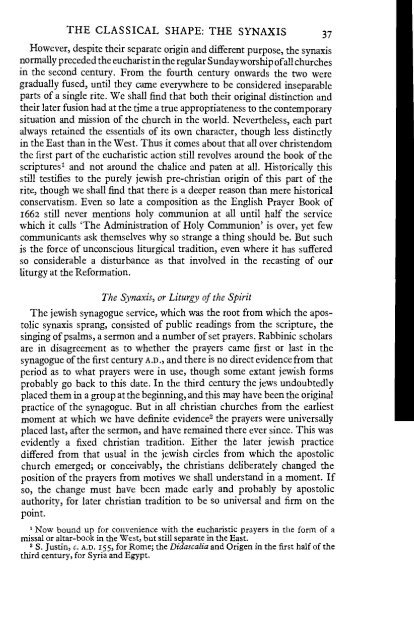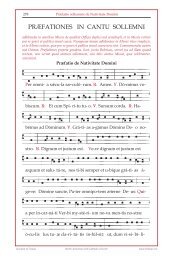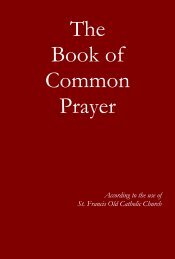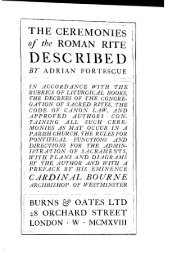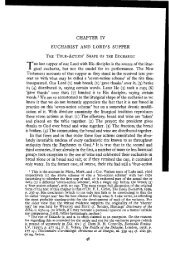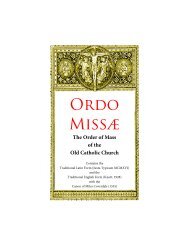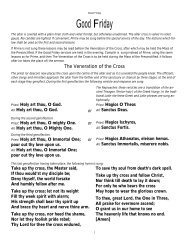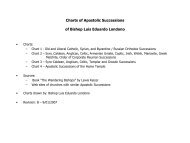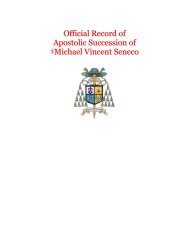The Shape of the Liturgy; Chapter III
The Shape of the Liturgy; Chapter III
The Shape of the Liturgy; Chapter III
You also want an ePaper? Increase the reach of your titles
YUMPU automatically turns print PDFs into web optimized ePapers that Google loves.
THE CLASSICAL SHAPE: THE SYNAXIS 37<br />
However, despite <strong>the</strong>ir separate origin and different purpose, <strong>the</strong> synaxis<br />
normallypreceded <strong>the</strong> eucharist in <strong>the</strong> regular Sundayworship<strong>of</strong>allchurches<br />
in <strong>the</strong> second century. From <strong>the</strong> fourth century onwards <strong>the</strong> two were<br />
gradually fused, until <strong>the</strong>y came everywhere to be considered inseparable<br />
parts <strong>of</strong> a single rite. We shall find that both <strong>the</strong>ir original distinction and<br />
<strong>the</strong>ir later fusion had at <strong>the</strong> time a true appropriateness to <strong>the</strong> contemporary<br />
situation and mission <strong>of</strong> <strong>the</strong> church in <strong>the</strong> world. Never<strong>the</strong>less, each part<br />
always retained <strong>the</strong> essentials <strong>of</strong> its own character, though less distinctly<br />
in <strong>the</strong> East than in <strong>the</strong> West. Thus it comes about that all over christendom<br />
<strong>the</strong> first part <strong>of</strong> <strong>the</strong> eucharistic action still revolves around <strong>the</strong> book <strong>of</strong> <strong>the</strong><br />
scriptures! and not around <strong>the</strong> chalice and paten at all. Historically this<br />
still testifies to <strong>the</strong> purely jewish pre-christian origin <strong>of</strong> this part <strong>of</strong> <strong>the</strong><br />
rite, though we shall find that <strong>the</strong>re is a deeper reason than mere historical<br />
conservatism. Even so late a composition as <strong>the</strong> English Prayer Book <strong>of</strong><br />
1662 still never mentions holy communion at all until half <strong>the</strong> service<br />
which it calls '<strong>The</strong> Administration <strong>of</strong> Holy Communion' is over, yet few<br />
communicants ask <strong>the</strong>mselves why so strange a thing should be. But such<br />
is <strong>the</strong> force <strong>of</strong> unconscious liturgical tradition, even where it has suffered<br />
so considerable a disturbance as that involved in <strong>the</strong> recasting <strong>of</strong> our<br />
liturgy at <strong>the</strong> Reformation.<br />
<strong>The</strong> Synaxis, or <strong>Liturgy</strong> <strong>of</strong> <strong>the</strong> Spirit<br />
<strong>The</strong> jewish synagogue service, which was <strong>the</strong> root from which <strong>the</strong> apostolic<br />
synaxis sprang, consisted <strong>of</strong> public readings from <strong>the</strong> scripture, <strong>the</strong><br />
singing <strong>of</strong> psalms, a sermon and a number <strong>of</strong> set prayers. Rabbinic scholars<br />
are in disagreement as to whe<strong>the</strong>r <strong>the</strong> prayers came first or last in <strong>the</strong><br />
synagogue<strong>of</strong> <strong>the</strong> first century A.D., and <strong>the</strong>re is no direct evidencefrom that<br />
period as to what prayers were in use, though some extant jewish forms<br />
probably go back to this date. In <strong>the</strong> third century <strong>the</strong> jews undoubtedly<br />
placed <strong>the</strong>m in a group at <strong>the</strong> beginning, and this may have been <strong>the</strong> original<br />
practice <strong>of</strong> <strong>the</strong> synagogue. But in all christian churches from <strong>the</strong> earliest<br />
moment at which we have definite evidence 2 <strong>the</strong> prayers were universally<br />
placed last, after <strong>the</strong> sermon, and have remained <strong>the</strong>re ever since. This was<br />
evidently a fixed christian tradition. Ei<strong>the</strong>r <strong>the</strong> later jewish practice<br />
differed from that usual in <strong>the</strong> jewish circles from which <strong>the</strong> apostolic<br />
church emerged; or conceivably, <strong>the</strong> christians deliberately changed <strong>the</strong><br />
position <strong>of</strong> <strong>the</strong> prayers from motives we shall understand in a moment. If<br />
so, <strong>the</strong> change must have been made early and probably by apostolic<br />
authority, for later christian tradition to be so universal and firm on <strong>the</strong><br />
point.<br />
1 Now bound up for convenience with <strong>the</strong> eucharistic prayers in <strong>the</strong> form <strong>of</strong> a<br />
missal or altar-book in <strong>the</strong> West, but still separate in <strong>the</strong> East.<br />
2 S. Justin, c. A.D. 155, for Rome; <strong>the</strong> Didascalia and Origen in <strong>the</strong> first half <strong>of</strong> <strong>the</strong><br />
third century, for Syria and Egypt.


